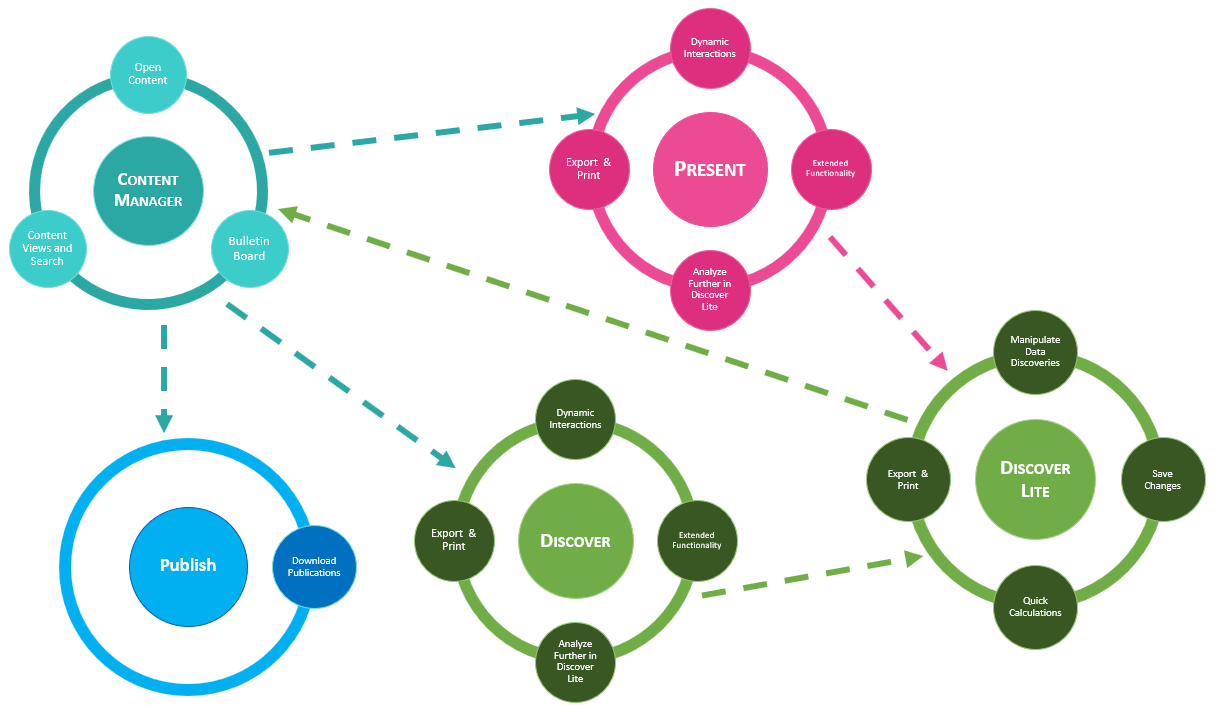The Viewer client is a lite version of Pyramid, giving non technical users the ability to access and interact with live content within a streamlined interface. While the "Pro" client is comprised of 6 main modules, heavily focused on sophistication and content authoring: Model, Discover, Formulate, Present, Publish and Illustrate. Unlike the pro's, viewers are generally focused on report-consumption rather than report-building. As such viewers primarily have "live" access to Discover and Present content, access to the rendered results from Publish, as well as access to a simplified content manager.
How are the Viewer Components Related?
Viewers have access to a streamlined application optimized to meet the needs of content consumers. The components that make up the Viewer client provide users with the tools needed to view and interact with reports that have been shared with the user.

Content Manager and Bulletin Board
The content manager is the area of the tool where content items are stored . You can find these items in their folder locations in the Content Explorer, or via the various list views, like your Favorites, Recents, or Most Used.
Housed with the content manager is the "Bulletin Board" - a centralized interface allowing use see and access publications, alerts, subscriptions, and conversations that have been shared with the user.
Published Content
In the 'Pro' client, report-builders use the full Publish model to design static analytics reports that are then exported and shared on a scheduled basis. Publications are comprised on multiple data discoveries, and may include other content items, across several pages. Although Viewers do not have access the Publish model, Pro users can share publications with you via the bulletin board. Depending on your organization's license type, they may also share publications with you via email.
You can download publications that have been shared with you via the Publications Board.
Discover
Report-builders use Discover to build a range of visualizations, called 'data discoveries'. In the Viewer client, discoveries are displayed in a streamlined version of Discover. Discoveries can be opened from the content manager or via a direct link that has been shared with you.
You can dynamically interact with the discovery, using functions like drill-down, quick filter, dice, and more. You can also access extended functionality, like scheduled data alerts, conversation threads, scheduled content subscription, and guided actions. The discovery can be exported to a chosen output for printing.
You can perform further analysis on the discovery by opening it in Discover Lite, where you can make changes and manipulate the query; you can then save the edited query to your own personal content folder.
Discover Lite
Discover Lite provides a simplified interface where users can quickly analyze data on the fly. Viewers can open selected queries from Discover (and Present) and then change the query as needed. You'll have access the data model that was queried, meaning you can change all the inputs (measures and hierarchies) if required.
You can also construct formulations, and print and export the discovery. Once finished, you can save the discovery to you own personal content folder in the content explorer.
Present
Presentations are interactive dashboards made up of multiple data discoveries placed over a number slides. Presentations can also include other content, like slicers, images, dynamic text, and infographics. Presentations are viewed within the Pyramid application.
Viewers can open presentations from the content manager or via a direct link that has been shared with you.
You can dynamically interact with the queries in presentations, and you can cross highlight and cross filter between queries. You can also access Smart Insights, to expose insights about the selected visualization, generated by AI algorithms.
You can export and print the presentation, or specified slides in the presentation. And you can open selected queries in Discover Lite (described above) for further analysis.